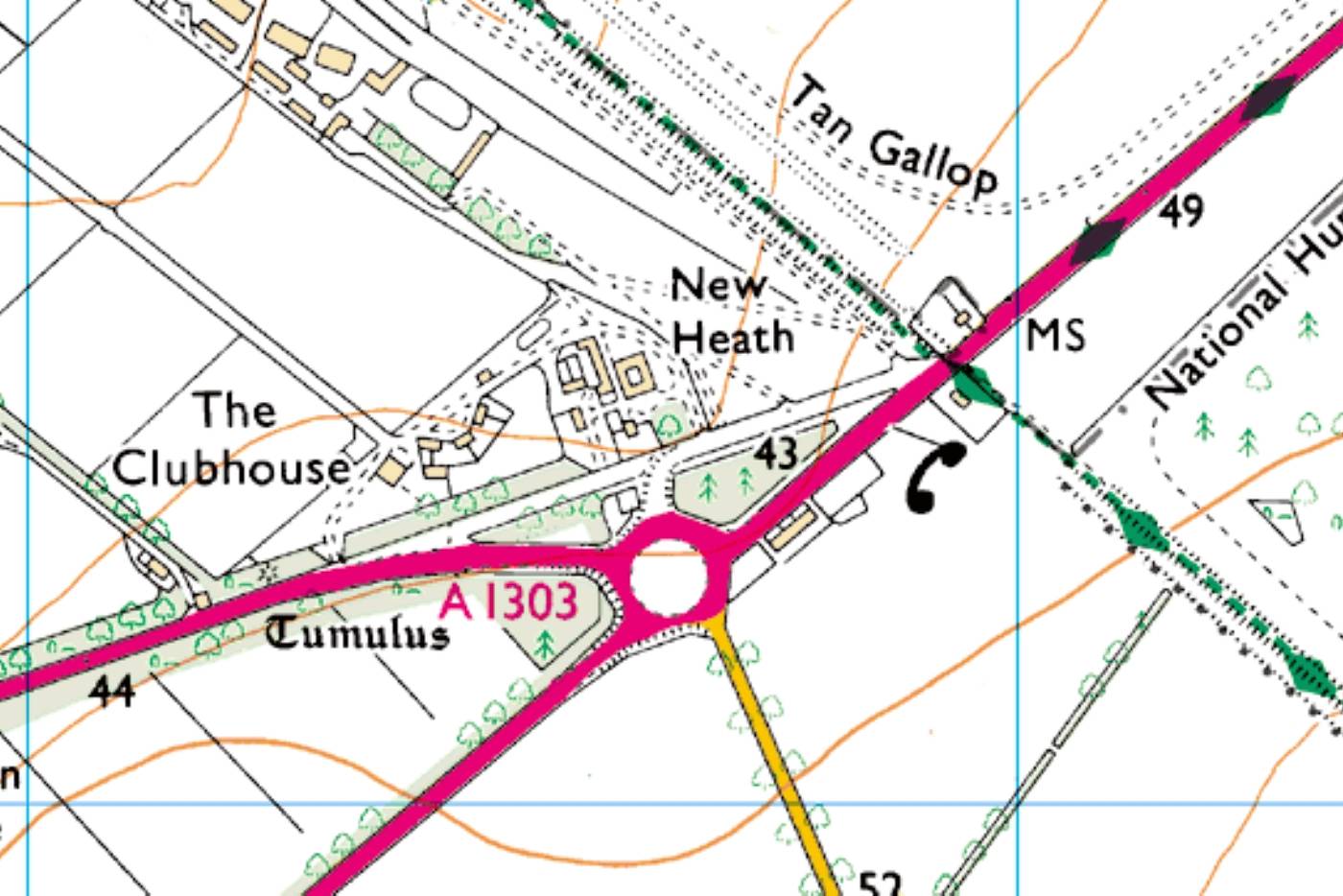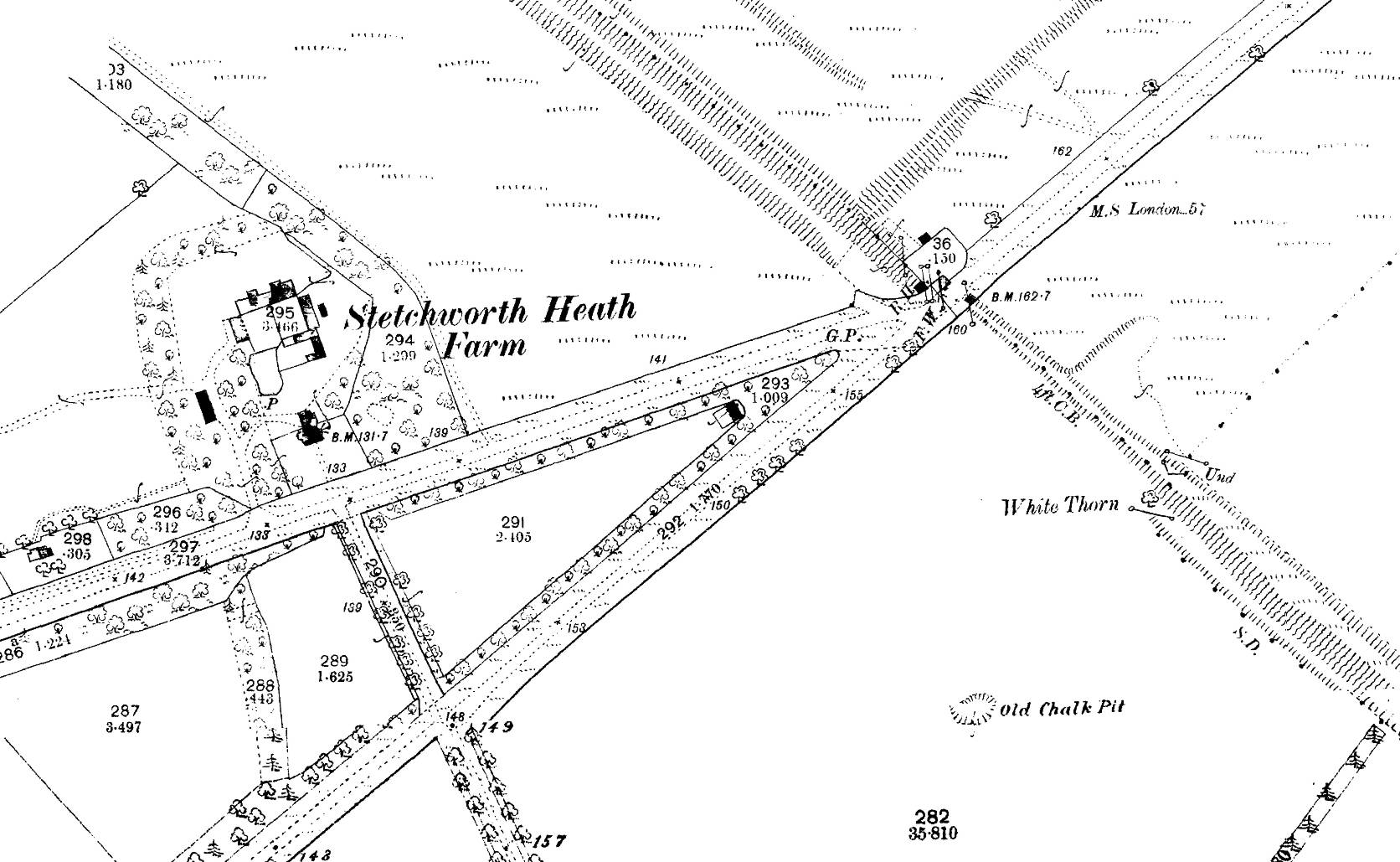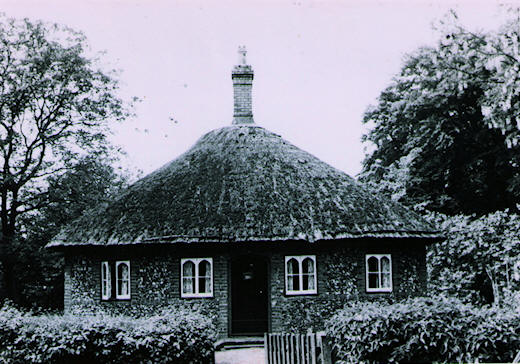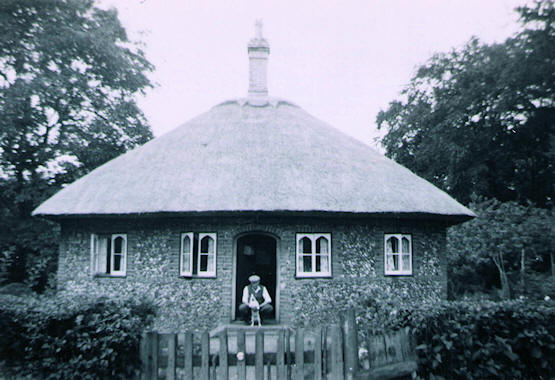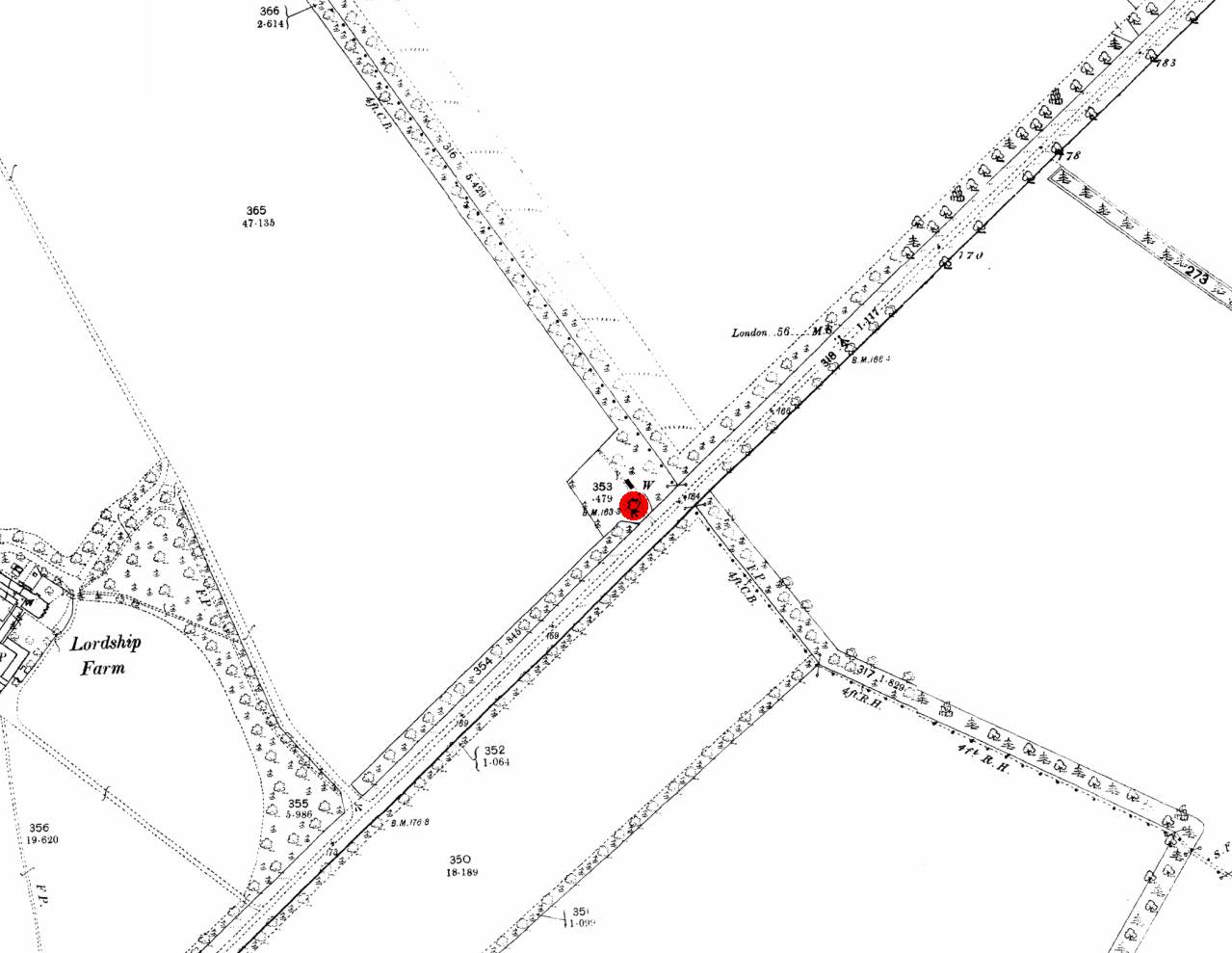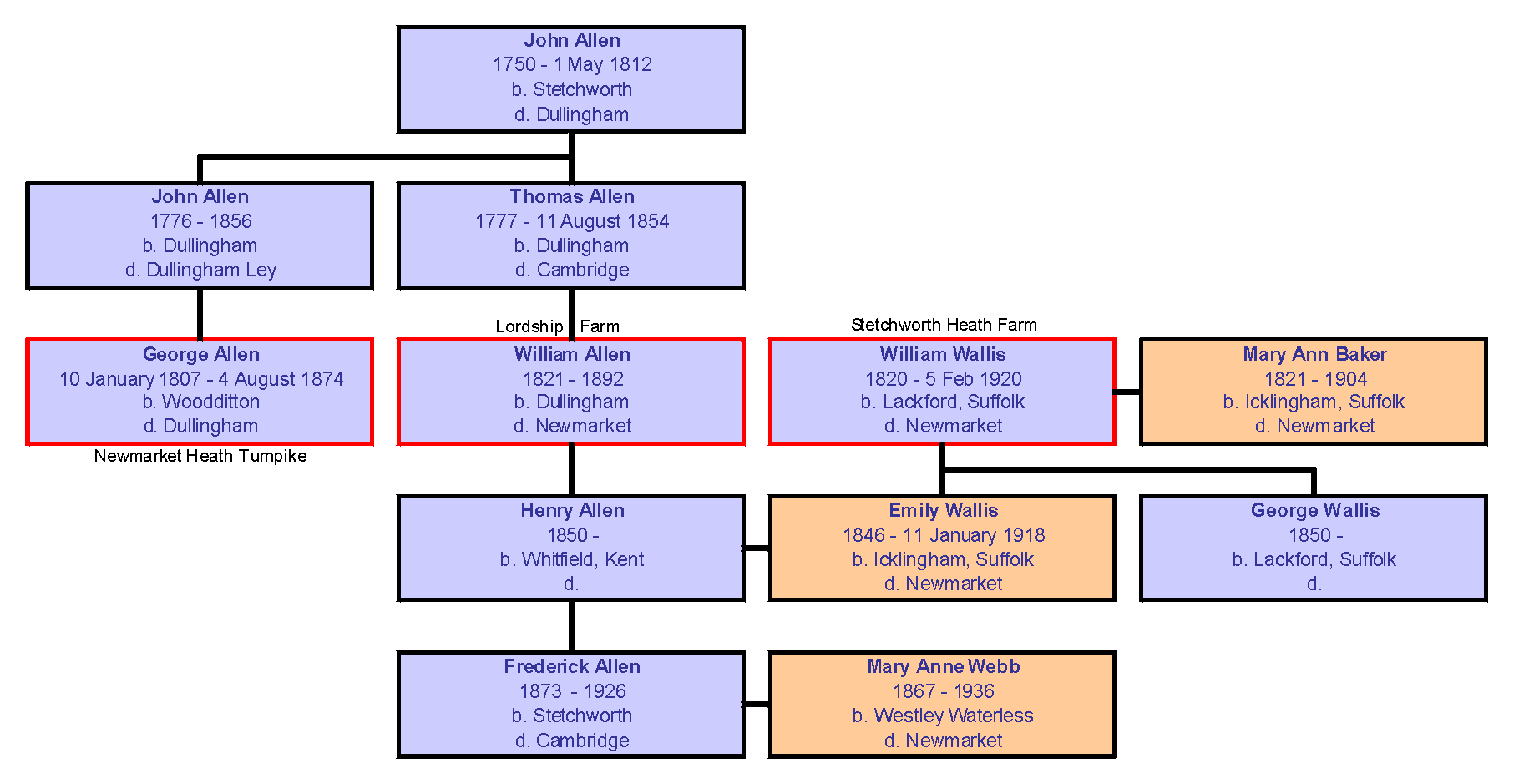The London Road
- As far as Newmarket is concerned the 'London Road' starts from the Devil's Dyke, passes by the end of the
July Racecourse, continues on along the road towards Six Mile Bottom
and at its conclusion ends up at London, approximately 57 miles
away. In modern road nomenclature this is now the A1304 .... before the construction of the Newmarket bypass it was the A11.
The roundabout that now stands at the entrance into the July Racecourse is known as the Stetchworth Toll, and that name gives a clue as to what existed along this road at one time. The roundabout hadn't been built at the time of the 1961 map above - instead the Cambridge Road coming from Newmarket split at the gap in the Devil's Dyke, with one road continuing on towards Cambridge (the Cambridge Road - part of which is still there and runs past the entrances to the July Racecourse and National Stud - it eventually became what is now the A1303 - formerly the A45) and the other, which is the main interest on this page, continuing straight on as the London Road.
Of course regardless of all these modern names this road is in essence the Icknield Way, and it's route is of significant importance to the existence of Newmarket - further details about this can be found on the page for the Origins of Newmarket.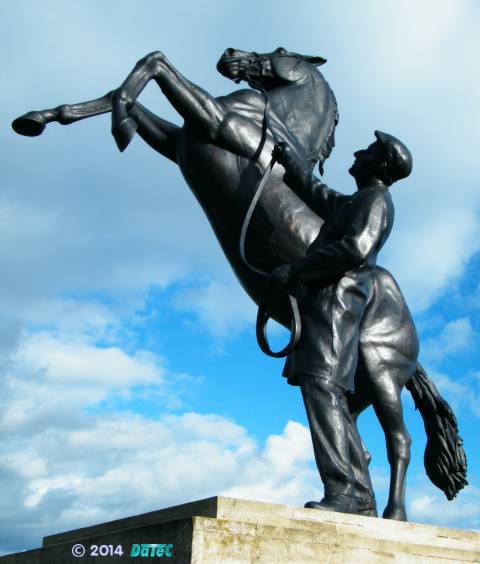
The Newmarket Stallion - on the Stetchworth Toll roundabout
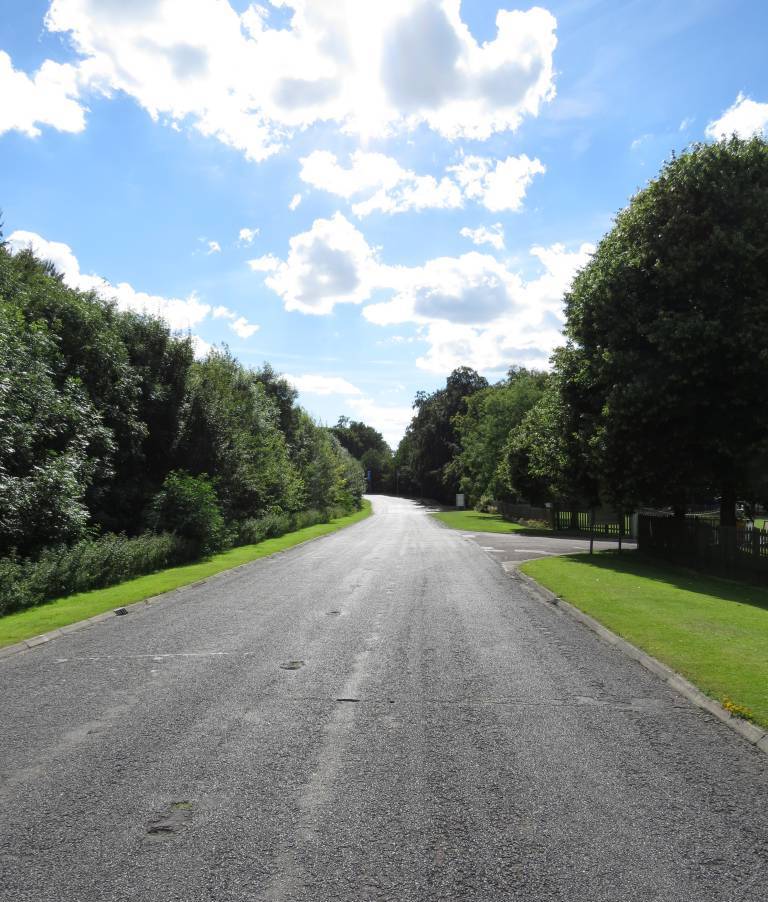
The Old Cambridge Road - 2016
- showing the entrances into the July Racecourse
and the National Stud on the right
[the gap in the trees straight ahead
shows the original route of the road}
The particular area of interest for this page concentrates on the section between the Devil's Dyke and Lordship Farm (refer to the map above).
- [Many Newmarketonians also call the mile-long stretch from
Hamilton Road up to the Devil's Dyke the 'London Road' - I do -
but equally many also call it the 'Cambridge Road' ....
technically it's both.
Then of course, due to its very bad car accident record, at one time many called it the 'Murder Mile'.
Important note to any cartographers out there though (map makers) - that road has never been called the 'Barbara Stradbroke Avenue' - that particular title is only applicable to the grassy tree-lined stretch that runs parallel on the south eastern side of the main road. The road's only real title these days is the A1304.
Admiral The Honourable Henry John Rous (after whom Rous Road was named) - his brother was John Edward Cornwallis Rous, 2nd Earl of Stradbroke and his grandson; John Anthony Alexander Rous, 4th Earl of Stradbroke, married Barbara Grosvenor, daughter of Lt.-Col. Lord Arthur Hugh Grosvenor (bit convoluted this) - hence she was Lady Barbara Stradbroke. This John Rous was at one time the Lord Lieutenant of Suffolk and the row of trees along the side of this road are named in honour of her.]
-
Stetchworth Heath Farm - the National Stud
-
It would appear by comparison between these two maps that many of
the buildings that were part of the Stetchworth Heath Farm
eventually became those of the National Stud.
- Stetchworth Heath Farm was built next to the July Racecourse
sometime before 1861, on 240 acres of land allotted for tithe.
It was originally owned by Dalham born Charles Jillings - the farmer living at nearby Hall Farm. He first appears there on the Stetchworth Electoral Register of 1857 and is shown on the censuses at Hall Farm from 1861. So in the absence of any other records it would appear that Heath Farm was newly built around this time for him.
Bury Free Press
Saturday 20 March 1869
Samuel Ashton, tramp, was brought up the charge of having wilfully set fire to a wheat stack belonging to Mr. Jillings, the Heath farm, Stetchworth. Wednesday, the 10th instant.
Bury Free Press
Saturday 02 September 1882
MR. J. CARTER JONAS HAS the following FARMS TO LET, with Possession at Michaelmas next.
HEATH FARM, STETCHWORTH, a capital Accommodation Farm, within a Mile of Newmarket.
-
Mat Dawson
-
Subsequent to this advert, in 1884 Heath Farm was leased to the racehorse trainer Mathew
Dawson. Further details about him and his family can be found on
the page for the Dawson Family.
Cambridgeshire and Huntingdonshire Archives
Manor of Stetchworth
Earl of Ellesmere to Matthew Dawson of Newmarket, Cambs.
Counterpart of 14-year Lease of Heath Farm, Stetchworth, at £300 p.a. 5 schedules of lands, etc.
12 May 1884
R53/23/34
The lease ran from 1884 upto 1893 and during that time the farm changed from being an agricultural one to becoming a stud farm.
-
William Wallis
- Born in Lackford, Suffolk in 1820
William Wallis was the farmer-tenant, the 'Farm Bailiff', at Stetchworth Heath Farm from
around 1871, until the end of Mat
Dawson's lease. He subsequently moved to
St Philips Road in Newmarket, where he's shown on the 1901 census.
William died in Newmarket in 1908.
William's son George Wallis and his family are also shown in Heath Farm Cottages on the 1891 census. On the 1911 census George's address is given as No.4 London Road Cottages, London Road, Stetchworth Near Newmarket, Cambs. This is the row of 10 houses on the opposite side of the road to the July Racecourse, which (as per the date plaque on the houses) had been built in 1897._1871_Census.jpg)
Heath Farm - 1871 Census
London Road Cottages 2016
-
Lord Marcus Beresford
-
In 1893 Heath Farm had a new owner:-
Thoughts Upon Sport
by Harry R. Sargent
Published 1895
Mat Dawson
Heath Farm.- In 1893 he sold the lease of Heath Farm to Lord Marcus Beresford, and leased, from the Jockey Club, The Marsh, which adjoins Melton House, and there he now has his valuable stud of brood mares.
- From 1890 Lord Marcus Talbot de la Poer Beresford had been
running the stables of the Prince of Wales,
most notably at Sandringham. It was he who renamed the farm
here as Heath Stud Farm.
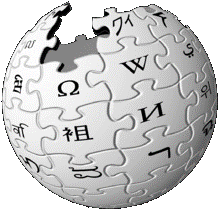 https://en.wikipedia.org/wiki/Lord_Marcus_Beresford
https://en.wikipedia.org/wiki/Lord_Marcus_Beresford
Horse-breeder's handbook
by Joseph Osborne
Published 1898
Mimic, whose doings on the racecourse will be found recounted on the succeeding page, is the companion of Florizel II. and Worcester at the Heath Stud Farm, close by the July course, where the stud of Lord Marcus Beresford is located.
FLORIZEL II. (the property of his royal highness the prince of wales, K.G., SANDRINGHAM, NORFOLK.) Will he located during 1898 and following Seasons at The Heath Stud Farm, next the July Course, Newmarket ...
WORCESTER. (the property of J. B, JOEL, ESQ., DRAPER'S GARDENS.) Will he located during 1898 and following seasons at the Heath Stud Farm, next the July Course, Newmarket ...
Although Beresford appears to have been the owner here until his death in 1922, the newspaper reports don't seem to mention him much at Heath Stud Farm after 1910; the year when the Prince of Wales, by then King Edward VII died. And in the next year on the census a new tenant had appeared here.
-
The Smallwoods
-
By 1911 Frederick Ernest Smallwood had taken over as the
'manager of stud & farm' at Heath Farm. Previously on the 1901
census there were two houses listed here - Heath Farm, where a
Frederick Farley was the 'farm manager' and Heath Stud Farm, where
Frederick Smallwood was the stud groom - clearly the stud farm
site was continuing to expand and evolve at that time.
Western Morning News
Saturday 17 January 1925
NEWMARKET'S BEST
Newmarket, Friday.-The various racing studs up and down the country are now in the throes of their busiest period of the season. I paid a flying visit this morning to one of the best-conducted studs in the Newmarket district, which formerly belonged to the late Lord Marcus Beresford. It is known as the Heath Stud Farm, and the present owner. Mr. F. Smallwood, was associated with Lord Marcus Beresford for a great number of years, during which period some famous horses were located at his stud.
Mr. James De Rothschild's mares and foals were located at the Heath stud during the war, and the association thus formed has been kept ever since.
His present stallion located there is Beppo, the sire of Picaroon, whom many consider the champion juvenile of the season just ended.
Frederick died on 19th June 1928 at Stetchworth Heath Stud Farm:-
_1928_Probate.jpg)
Jack Smallwood was Frederick's son - born here at Heath (Stud) Farm in 1895.
From the article below it would seem that the trainer Felix Watmough Leach went into business here with Jack's cousin Stanley Smallwood:-
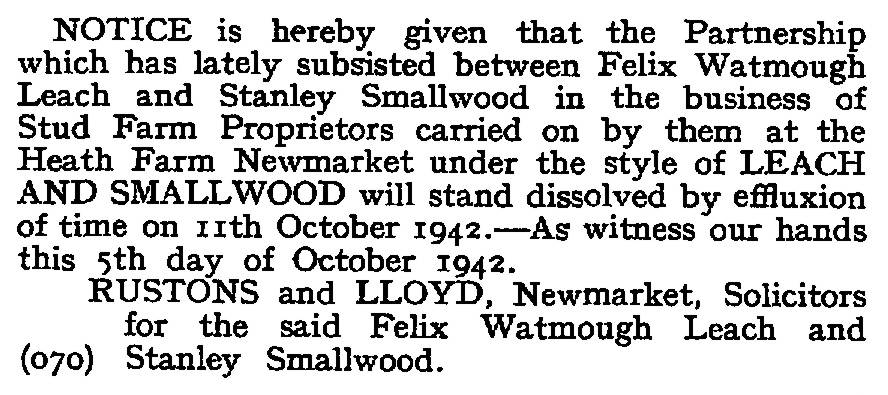
London Gazette 9th October 1942 - page 4408
To explain some of this, let's go back a few years - Brothers Frederick Ernest and Alfred Smallwood were both born in the 1860s at Middlethorpe in Yorkshire. And while Frederick Ernest and his son Jack were here at Heath Farm in 1911, Alfred and his son Stanley were just along the Cambridge Road at Egerton Stud House. Stanley was a Stud Groom there at that time; so it's no surprise that he later entered into a partnership with the trainer Felix Watmough Leach here at Heath Farm.
Further details about Felix can be found on the page for The Chestnuts - No.16 High Street, where his veterinarian brother, Edward Hugh Leach lived.
It would seem that the Smallwood family had been running a stud for some time at Middlethorpe and had quite some historical racing success:-
 https://en.wikipedia.org/wiki/Voltaire_(racehorse)
https://en.wikipedia.org/wiki/Voltaire_(racehorse)
-
In 1936 stanley Smallwood also became manager of the Aislabie Stud
in Stetchworth High Street.
[Robert Kenneth Harrison from Stetchworth died on 17th December 1935 at the County Hospital, Hertford.]Portsmouth Evening News
Yorkshire Post and Leeds Intelligencer
Sheffield Independent
Tuesday 28 January 1936
TO MANAGE AISLABIE STUD Mr. Stanley Smallwood, manager the Heath Stud, Newmarket, will take over the management of the Aislabie Stud at Stetchworth this week-end. The four stallions at the Aislabie Stud are Lemnarchus, Stingo, King’s Oven, and B.D.A. The former manager at Aislabie was Mr. R. K. Harrison who died last month as the result of a heart attack while driving from Hertford to Newmarket.
-
The National Stud
- The farm here was still known as Heath Stud Farm on the 1961 map
at the top of this page,
and by 1963 the horse racing Betting Levy Board ran it.
-
In 1916 Colonel William Hall Walker, 1st Baron Wavertree, had gifted his bloodstock at Tully in Ireland to the British Government for
the purpose of founding a national stud.
 https://en.wikipedia.org/wiki/William_Walker,_1st_Baron_Wavertree
https://en.wikipedia.org/wiki/William_Walker,_1st_Baron_Wavertree
- In 1967 Queen Elizabeth II officially opened the site here
as the 4th home of the National Stud.
 |
-
George Allen - Newmarket Heath Turnpike
-
Born in Woodditton on 10th January 1807, George was the last toll
keeper at the Newmarket Heath Turnpike Toll Gate:-
Newmarket Heath Turnpike Trust
Lease of the toll
Date May 1869-June 1870
George Allen. 1 year
ReferenceNo T/N/AT19
CRO Cambridge
By 1871 George and his wife Mary had moved to live in Church Lane, near St Mary's church in Newmarket, where he died on 4th August 1874.
George is buried in Dullingham church yard. Mary died 8 years later and was buried on 7th December 1882 alongside George.
Newmarket Heath Turnpike Trust
The Newmarket Heath Turnpike Trust was set up in 1763 by an Act 3 George III, cap. 32.
It then extended from the west end of the town of Newmarket, over Newmarket Heath, by the Devil's Ditch to the further side of the parish of Fulbourn (at Worsted Lodge).
By an Act of 1775, 15 George III, cap. 68, the Trust was continued and extended to cover the road through Newmarket to the small bridge or tunnel at its east end to join the Newmarket-Thetford Turnpike, and from near the Devil's Ditch to join the Paper Mills Turnpike leading to Cambridge at the First Rubbing House in Swaffham Bulbeck.
The Trust was further continued by Acts of 46 George III, 1806, and 10 George IV, cap. 1iii, 1829.
It was further continued by the Annual Turnpike Acts Continuance Acts of 1866 and 1868, and under the provisions of the latter expired on 30 June 1870.
CRO Cambridge
The Newmarket Heath Tollgate was located at the London Road Gap in the Devil's Dyke, highlighted in red on the map above. Although this map is dated 1890, 20 years after the turnpike closed, the position of the tollgate cottage and the gate across the road is still clearly visible.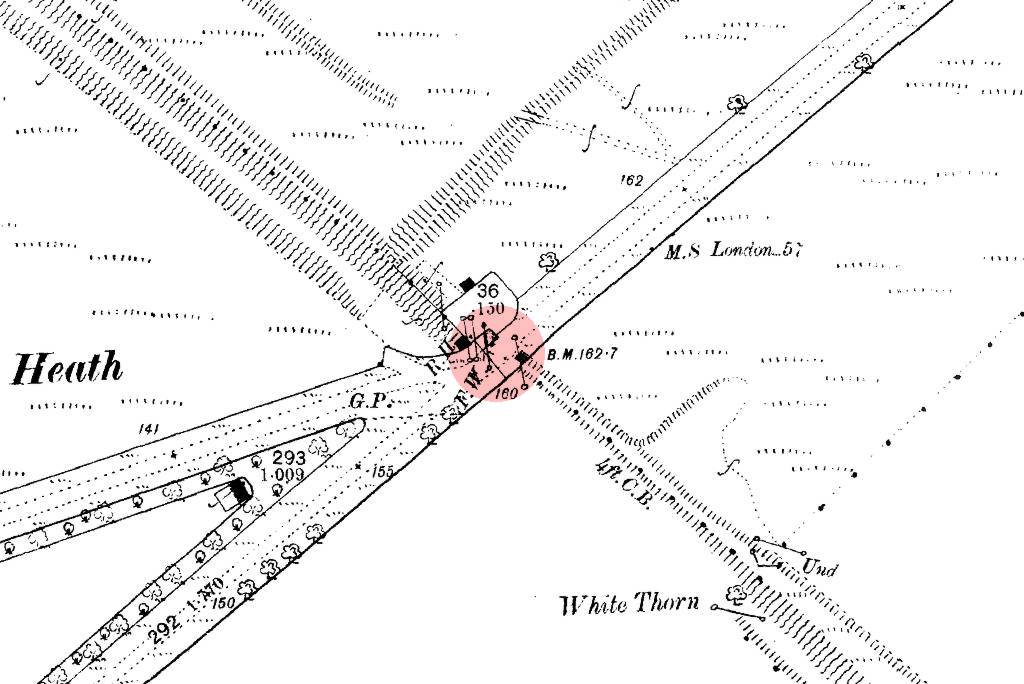
Newmarket Heath Tollgate 1890
F.W. stands for Face of Wall - the front of the tollgate.
R.H. stands for Road House - what had been the tollgate cottage - road houses had food, lodging and supplies available for travellers.
G.P. stands for Guide Post - the signpost that would have shown the road to Cambridge one way and to London the other.
As the map shows, the cottage actually stood right up against the north-west side of the road .... nothing is left at that location today to give any indication that it ever existed.
-
William Allen - London Road Heath Cottage, Lordship Farm
-
Born in Dullingham in 1821 and baptised at Dullingham St Mary's
church on 10th June 1821, William was George Allen's cousin. Initial
research into his life via the censuses, proved quite confusing as
to where he actually lived. Firstly in 1851 he's listed at London Road,
then in 1861 at Heath Cottage, Estate Cottage in 1871 and then in
1881 the location of this becomes much clearer - Lordship Farm. From
the position his name appears in the censuses it
doesn't seem that he moved house during this time - so the
question was, what house could be called London Road Heath Cottage on
Lordship Farm(?).
Known locally as Toll Cottage (though of course as detailed above the actual toll was a little further along the London Road) this building no longer exists and the location of it is now just a fenced-off wooded area along the side of the road on the way to Six Mile Bottom.
Fortunately there are photos of the cottage and it's location is clearly shown on early maps.
Further details about Lordship Farm can be found on the British History Online web site:-
http://www.british-history.ac.uk/vch/cambs/vol6/pp157-170
But here's an outline of one of the most relevant details - 'Lordship farm, whose northern corner adjoined the old Newmarket Round Course, was occupied between 1877 (corrected) and 1892 by the royal trainer, Richard Marsh'. So living at the Toll Cottage (which was part of the farm estate) between 1851 until at least the 1880s William Allen would have been a member of the estate staff working for Richard.
On the 1881 census 59yo William is at schedule No.118 and Richard John Marsh is at No.123. On this census the various houses on Lordship Farm contain a mixture of agricultural labourers (William) and stable lads - so clearly William witnessed the transition of it from being a working farm to becoming the stud farm that it is now.
William's time came to a rather sad end though: as he spent his last years in Newmarket Union Workhouse in Exning Road (later White Lodge Hospital - Newmarket General Hospital). He's shown there on the 1891 census, listed as an inmate and former agricultural labourer, and he died there a year later on 20th June 1892 aged 71.
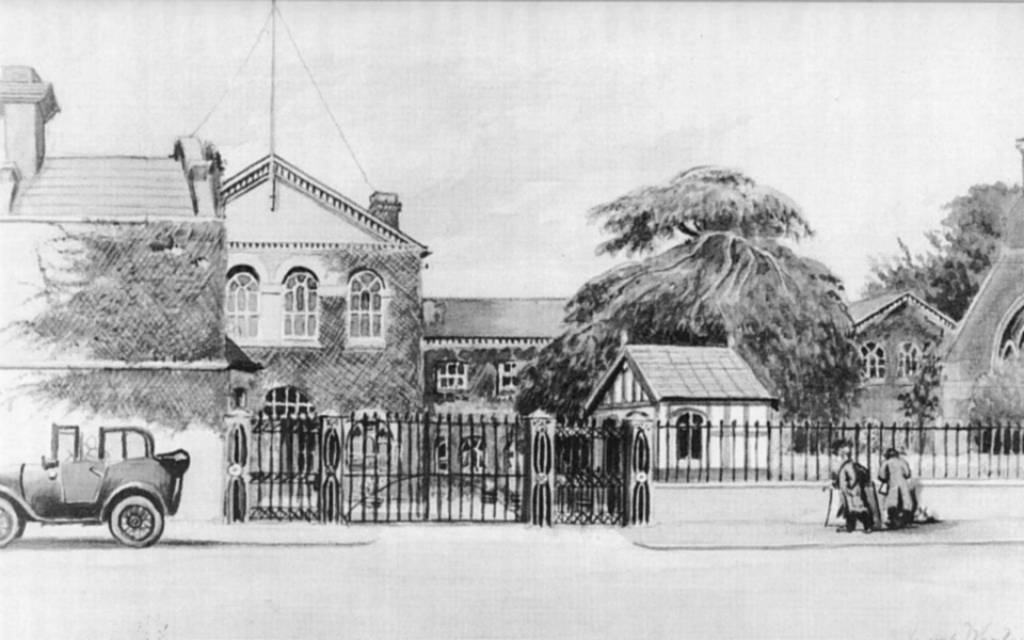
Painting of Newmarket Union Workhouse in 1927
-
Richard John Marsh
- Richard was trainer to William Douglas-Hamilton, 12th Duke of
Hamilton.
 https://en.wikipedia.org/wiki/Richard_Marsh_(horseman)
https://en.wikipedia.org/wiki/Richard_Marsh_(horseman)
- He bought Lordship farm at auction on Monday 8th October
1877.
Cambridge Independent Press
Saturday 08 September 1877
Lordship Farm, Swaffham Bulbeck, Cambridgeshire. BE SOLD BY AUCTION, BY Mr. J. CARTER JONAS, On Monday, the 8th of October, 1877, by direction of Mr. Newman, in consequence of the Farm being sold. all the Valuable LIVE AND DEAD FARMING STOCK, And few Lots of Furniture.
- Nearby Egerton Stud was being rebuilt in 1891-3 by the owner
of Stetchworth Estate; Francis Charles Granville Egerton, 3rd Earl
of Ellesmere, who developed it as a racing establishment. Lord Ellesmere's land agent approached Richard
to see whether he was interested in being the tenant there. Hence
subsequently Richard moved from Lordship into Egerton in November 1892 with 54
horses.
Owners of the horses at the new stud continued to be the Duke of Hamilton and also Spencer Compton Cavendish, 8th Duke of Devonshire - further details about him can be found on the page for Beaufort House - No.136-142 High Street, where he lived from 1902.
Richard was then offered the opportunity to train the horses of the Prince of Wales (later King Edward VII) and 8 arrived at the beginning of 1893.
Two of the most famous horses to be trained at Egerton were the Prince's Persimmon, which won the Derby in 1896, and Diamond Jubilee, the triple crown winner of 1900. Royal horses continued to be trained at Egerton, under Marsh and his successor Willie Jarvis, until Jarvis's death in 1943.
-
Richard John (Dick) Marsh was born at Smeeth in Kent, and contrary to both his Wiki page and his newspaper obituary below, he was actually born on 31st December 1850. That this was his birth date and not 1851 (as is stated elsewhere) is proven by both the engraved details on his gravestone at Little Shelford All Saints churchyard and by the fact that the Smeeth parish register shows that he was baptised on 28th January 1851 .... and then on the 1851 census (30th March 1851) he's listed as being 3 months old.
His parents were farmer Richard Marsh and Mary Matilda (neé Smith). By 1871 his family had moved to Epsom and as detailed above he moved here to Lordship Farm in 1877.
Richard married twice, firstly to Olive Thirlwell on 31st October 1876 at Stoughton in Sussex, and secondly to Grace Darling in 1900 at Marlborough in Wiltshire (Olive had died previously on 1st July 1896 at Egerton House).
Richard retired from training at the end of 1924 and he and his his wife Grace moved to live at Great Shelford.
A very detailed record of Richard's racing and training career are given in the following newspaper obituary, which appeared in numerous publications across the country on Saturday 20th May 1933, the day he died.
Various Newspaper Reports
Mr. Richard Marsh
Saturday 20 May 1933
Mr. Richard Marsh, former trainer of the King's racehorses, died at his home at Great Shelford, Cambridgeshire, this afternoon.
Mr. Marsh had been ill for some time and had been sinking throughout the day.
His wife, who had nursed him during his illness, was with him at the end.
Dick Marsh, as he was familiarly known to all sportsmen, was born December 1851, at Smeeth, Kent, where his father was a large and prosperous farmer.
He began racehorses early and one of his principal flat race successes was the New Stakes Ascot on Temple, but increasing weight caused him join the ranks of cross-country jockeys.
This branch of the sport was amongst the best riding and among his important wins was that on The Nun in the Grand Sefton Steeplechase.
He rode in the Grand National on several occasions, and, though he never had the good fortune to win that race, he twice finished third.
He started as a trainer in 1872.
His patrons including several distinguished sportsmen, for whom he turned out many notable winners.
In 1893, when it was decided to transfer the horses owned by the late King Edward VII. then Prince of Wales, from Kingsclere to Newmarket, Marsh was selected as the Royal trainer on the advice of the late Lord Marcus Beresford, the manager of the Sandringham stud.
Three years later Mr. Marsh won the One Thousand Guineas for the Prince with Thais and followed it up by achieving the greatest of all Turf triumphs by winning the Derby with Persimmon.
Hopes were entertained that Thais would complete a memorable double by winning the Oaks, but, she found one too good for her in Lord Derby’s Canterbury Pilgrim.
Persimmon was only twice beaten during his career, in the Middle Park Plate as a two-year-old and the Princess of Wales Stakes the following year, St. Frusquin beating him on each occasion.
He won in stakes more than £34,000, his victories including, in addition to the Derby, the St. Leger, Jockey Club Stakes, Ascot Gold Cup, and Eclipse Stakes.
The dam of Persimmon was Perdita II, who had been purchased on the advice of the late John Porter for £900.
This mare was the foundation of King Edward’s racing successes. Previous to Persimmon she had foaled Florizel II, with whom Marsh won for the Prince the Manchester Cup, Ascot Gold Vase, the Goodwood Cup, and other races.
Perdita II also foaled Diamond Jubilee, who was destined to be enrolled among the comparatively few horses which have won all of the three great classics, the Two Thousand Guineas, the Derby, and the St. Leger.
In addition to the successes recorded above, Mr. Marsh won the Two Thousand Guineas with Paradox and Gorges, and the Ascot Gold Cup with Morion and Le Fleche.
He won the Stewards’ Cup three times in succession with Marvel, in 1890 and 1892, and Unicorn, in 1891.
The same measure of success did not attend Mr. Marsh's association with King George as with King Edward.
It was thought that with Friar Marcus and Knight of the Garter there was the possibility of classic successes, but both horses proved disappointing after their two-year-old careers.
With Weathervane, however, the Royal Hunt Cup Ascot was won for King George, and other important handicap successes gained for his Majesty were London Cry in the Goodwood Stakes and Prince Edward Handicap.
Mr. Marsh retired from training at the end of 1924, and was succeeded by Mr. W. R. Jarvis, as the Royal trainer.
Marsh's retirement was marked by many notable tokens of esteem.
His Majesty conferred on him the Royal Victorian Order, his fellow trainers presented him with a silver cup and cabinet cigars and a general testimonial organised by Sir Walter Gilbey and Mr. Somerville Tattersall realised £3,000.
As valued anything was the presentation of an illuminated Bible after a farewell service at the little chapel at Newmarket he had built, and where he had worshipped for many years.
Marsh left Newmarket on his retirement to live quietly at Shelford, some 20 miles away.
He there wrote the story of his life.
-
Joseph Cannon & family at Lordship Farm
- Following on from Richard, sometime before 1896 (he's shown in
Kelly's Directory for that year), until his death in March 1933,
Joseph Cannon (another
trainer) moved into Lordship farm - details about him and
his son Noel Victor
Cannon (who was born at Lordship Farm) can be found on the
page for Bedford Lodge.
During the time of these trainers the farm was further laid out in training gallops and paddocks, and in 1976 was still attached to the Egerton stud.
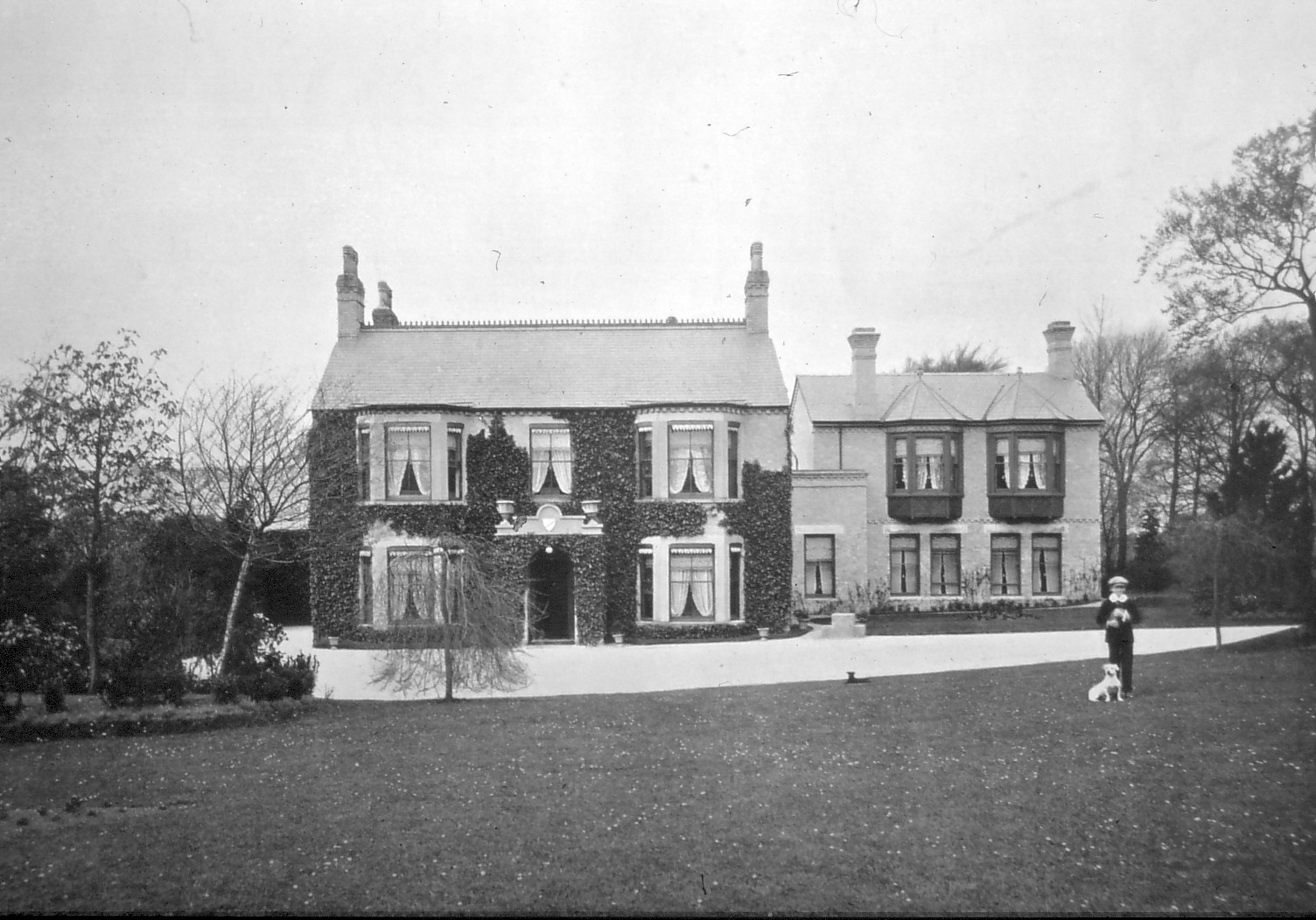
Lordship House c.1895
(Many thanks to Peter Norman for the above photo)
- just as an absolute guess Joseph's son Arthur was born in 1883 - so in 1895 he would have been 12yo
- does that little boy look about that age? - most probably - if so, it could be him(?)
Noel Victor Cannon wasn't born until 1898; so it definitely wasn't him.
- Arthur went on to become a journalist, but during WWI he joined the army and sadly died of his wounds on 2nd December 1917
 http://undyingmemory.net/Newmarket/cannon%20arthur.html
http://undyingmemory.net/Newmarket/cannon%20arthur.html
-
Allen Family
- William Wallis, George Allen and William Allen are actually all related,
either directly or by marriage - their family tree is shown
below:-
It's clear from all the details shown on this page that they and their families lived and worked in and around the London Road, and in particular the Newmarket Heath Turnpike, Lordship Farm and Stetchworth Heath Farm - later to become the National Stud.
Note from webmaster - the Frederick Allen shown at the bottom of this family tree is my Great Grandfather - my dad's maternal Grandfather. This photo is of him with his wife, my Great Grandmother, Mary Anne (neé Webb) at their home in Exning Road, Newmarket.
So William Allen and William Wallis are my Great x3 Grandfathers - and George Allen is their cousin / cousin-in-law - working along the London Road in the late Victorian period for royal trainer Richard Marsh, Mat Dawson and being the last toll keeper at the Newmarket Heath Turnpike.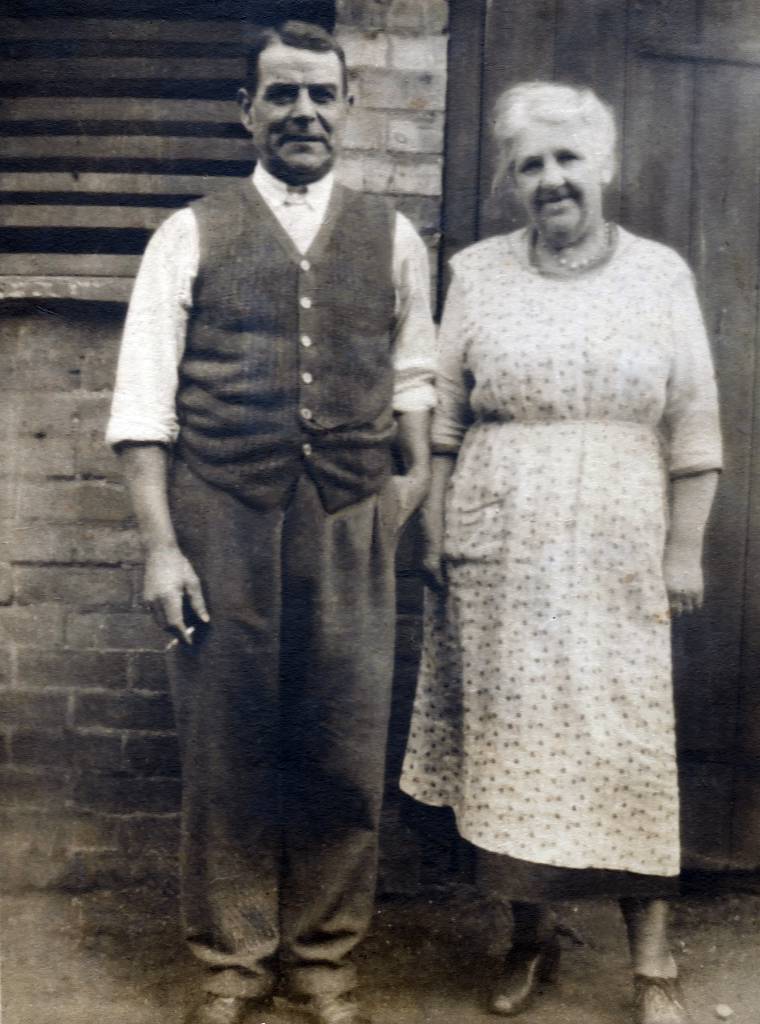
Frederick Allen and Mary Anne (neé Webb)
- Return to top of page
| IMPORTANT
NOTE from the WEBMASTER Content on this web site is attributed as appropriate to its original source or supply - can I ask that any copying or subsequent citation should respect the original author(s) and reference them or this web site as the source of this material Thank you |
|
| © 2016 | |
